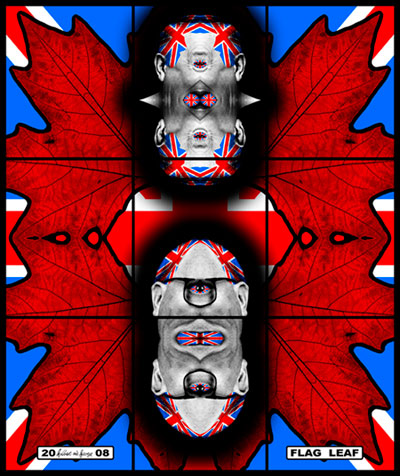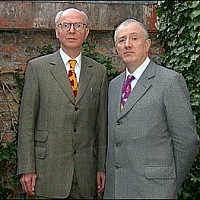
Galerie Baronian Francey 2 RUE ISIDORE VERHEYDEN 1050 Brussels Belgique
La galerie Baronian_Francey a l’immense plaisir et l’honneur de vous annoncer l’exposition d’œuvres de la dernière série en date de Gilbert & George : Jack Freak Pictures
Dans cette dernière série, celle qui à ce jour contient le plus de pièces, Gilbert & George continuent d’explorer les thèmes qui leur sont chers depuis de nombreuses années.
Tout ce qui concerne la vie est pour eux sujet potentiel de leur Art. Ils continuent dans ces derniers travaux d’enfoncer avec un calme et un détachement très anglais, les règles de la bienséance sociale.
Dans ces dernières images, le drapeau anglais, la cartographie du quartier de leur atelier situé dans l’East London (Fournier St.), les arbres, la citoyenneté, les graffitis et médailles sont autant de sujets dont ils tirent une narration passionnante et universelle.
Comme très souvent dans leur travail, les artistes sont à nouveau protagonistes des œuvres. Leurs visages et leurs corps apparaissent dans de nombreuses images.
Grâce à des procédés informatiques, ils se sont représentés de façon stylisée et souvent déformée en une métaphore de l’homme dans la ville attaché à ses normes sociales, religieuses et sexuelles.
Certaines de ces nouvelles pièces font exploser les images en fragments avant de les refondre dans de nouvelles formes kaléidoscopiques fascinantes mêlant le monstrueusement grotesque à un fouillis ornemental, réminiscence de l’art sacré.
Gilbert, né en 1943 en Italie dans la ville de San Martino, et George, né en 1942 en Angleterre à Devon, se sont rencontrés en 1967 dans les cours de sculpture de la Saint Martin’s School of Art d’Oxford et, depuis plus de 40 ans, ils vivent et travaillent ensemble à Londres, les deux ne faisant qu’un seul artiste, Gilbert & George.
Dès 1969 ils créent leurs premières Singing and Living Sculptures dans lesquelles ils sont à la fois sujet et objet, refusant de dissocier leurs performances de leur vie de tous les jours. Par cet acte, ils révolutionnèrent la pratique même de la sculpture.
Les premières photographies noir et blanc apparaissent au début des années 70 : de grands photos-montages composés de panneaux géométriquement divisés en cases rectangulaires et cernés de noir à la manière des vitraux. Ce sont ces photos qui vont leur apporter une renommée internationale.
Vers la fin des années 70, ils décident d’y introduire la couleur rouge et dans les années 80 la couleur évolue, le jaune, le rose et le bleu font leur apparition, tandis que l’imagerie se complexifie, les niveaux de signification se multiplient. Ces photos contiennent généralement des portraits des artistes eux-mêmes et sont l’occasion de tourner en dérision des sujets tabous comme la sexualité, la race, la religion, l’identité nationale, la politique….
Ces dernières années, leur rétrospective a voyagé en Europe et aux Etats-Unis, de la Tate Modern Londres, au Brooklyn Museum of Art de New-York, en passant par Haus der Kunst de Munich, le Castello di Rivoli à Turin, le Milwaukee Art Museum, le de Young Museum à San Francisco, et le Philadelphia Museum of Art….
En 2005, ils ont représenté la Grande Bretagne à la Biennale de Venise.
Gilbert et George n’ont plus exposé en Belgique depuis 1986 au Palais des Beaux-Arts de Bruxelles.
Une conversation réunissant Gilbert & George et Michael Bracewell sera organisée au Palais des Beaux-Arts dans le cadre Jeunesse et Arts Plastiques
A cette occasion un catalogue abondamment illustré, avec un essai du critique Michael Bracewell, sera publié par Hatje Cantz Verlag.
À l’automne 2010, Gilbert & George présenteront au Palais des Beaux-Arts leur série Jack Freak Pictures.
English Version
The Baronian_Francey gallery has the enormous pleasure and honour of announcing the exhibition of works from the latest series to date by Gilbert & George: Jack Freak Pictures.
In this latest series, which contains the largest number of pieces so far, Gilbert & George continue to explore themes that have been precious to them for a number of years. For them, everything concerning life is a potential subject for their art. In these recent works they have continued to break down the rules of social propriety with a calmness and a detachment that are very English.
In these images, the English flag, the map of the district of East London (Fournier St.) where their studio is located, trees, graffiti and medals are all subjects from which they draw an intriguing and universal narration. As very often happens in their work, the artists are once again protagonists of the pieces. Their faces and their bodies appear in numerous images. Thanks to computer processes they are represented in a stylized and often distorted way in a metaphor of human beings attached to their social, religious and sexual norms. Some of these new pieces make the images explode into fragments before melting them down again into new fascinating kaleidoscopic shapes mixing the monstrously grotesque with an ornamental jumble reminiscent of sacred art.
Gilbert, born in 1943 in Italy in the city of San Martino, and George, born in 1942 in Devon, England, met in 1967 in the sculpture courses of Saint Martin’s School of Art at Oxford. For more than 40 years, they have lived and worked together in London, the two making up a single artist, Gilbert & George.
In 1969 they created their first Singing and Living Sculptures in which they were simultaneously subject and object, refusing to separate their performances from their everyday life. By this act, they revolutionized the very practice of sculpture.
The first black and white photographs appeared at the beginning of the 1970s: large photo-montages consisting of panels geometrically divided into rectangular boxes defined in black in the style of stained glass windows. It was these photos that brought them international renown.
Around the end of the 1970s, they decided to introduce the colour red into them, and in the 1980s the colours evolved, as yellow, pink and blue made their appearance, while the imagery became more complex and the levels of meaning multiplied. These photos generally contain portraits of the artists themselves and are an opportunity to turn taboo subjects such as sexuality, race, religion, national identity, politics, etc. into irony.
During the last few years their retrospective has travelled in Europe and the United States, from the Tate Modern in London to the Brooklyn Museum of Art in New York, appearing also at the Haus der Kunst in Munich, the Castello di Rivoli in Turin, the Milwaukee Art Museum, the de Young Museum in San Francisco, and the Philadelphia Museum of Art. In 2005, they represented Great Britain in the Biennale of Venice.

